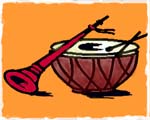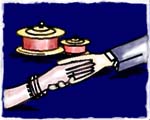The Significance of Rituals performed in a Hindu Marriage
A Hindu Wedding is not simply an exchange of vows and rings. It includes a
number of religious rites before and during the nuptials, which are performed
in the presence of family deities. These represent the importance of the bond
between a husband and wife. A Hindu marriage or «Vivaha» is incomplete
without the blessings of a spiritual or divine element.
Misri (Ring Ceremony)

All prayers in Hindu ceremonies start by invoking the blessings of Lord
Ganesha (Lord Ganesha unlike all the other Hindu deities has an elephant head
as a result of the unfortunate conditions explaining Lord Ganesh’s elephant
head – his own father axed off his son’s head and then replaced it with
that of the first animal he saw – the devout Hindu shows his lack of
preference between the Lords by making his preliminary prayers to Lord Ganesha). Seven married ladies (portraying 7 forms of God for each day of the
week) use red powder to make a Ganesh sign (clockwise swastika) on a pot of
misri (crystalline sugar) asking him to bless the couple and make the ceremony
run well.
The ladies also sew designs on a white piece of cloth to ward of any Nazar
(evil eyes cast) that may come upon the happy occasion. This cloth is worn by
the couple on the wedding day. (Note some couples leave the preparation of the
white cloth until the Ghari puja.)
A puja is done by the couple and their parents welcoming God in different
forms and asking for his blessings. They pray to Lord Ganesha, Varun Devta,
Laxmi & Narayan, the Gods on governing the 9 planets, and Om (i.e.
Triumverate Brahma, Vishnu and Shiva).
Garlands are exchanged by the couple in order to welcome each other into
their lives. This part of the ceremony is known as the Varmala.
As gold lasts forever, rings made of gold are exchanged by the couple in
order to represent a long married life. It is believed that the fourth finger
of the hand has a vein leading directly to the heart. Hence the groom wears
the ring on the fourth finger of his right hand and the bride wears hers on
the fourth finger of her left hand in order to form a complete heart.
The groom’s family places a basket of fruits, clothes, cosmetics or
ornaments on the girl’s lap (in her jholi) to represent her acceptance
into their family and bestowing her with happiness and prosperity.
The groom’s family gives a verbal promise of marriage and feeds misri
(crystalline sugar) to the girl's family to confirm the engagement. The eating
of sweet is considered auspicious by the Hindus and thus is eaten on all happy
occasions.
Mehndi (Henna - Painting of Hands & Feet)
 This festive occasion, originally of Muslim origin, is usually held in the
late afternoon. This is primarily a ladies tea-party; however the male
relatives are allowed to be present. On the mehndi, the future bride has
her hands and feet intricately patterned with a paste, which is a recipe of
henna, oil, lemon juice and some water tinted with tea. The application of
mehndi or henna takes about four hours to complete. Ideally, the bride-to-be
should not wash her hands until the paste has completely dried. Invitees at
the party also design each other's hands with mehndi. Mehndi signifies the
strength of love in a marriage. The darker the mehndi, the stronger the love. This festive occasion, originally of Muslim origin, is usually held in the
late afternoon. This is primarily a ladies tea-party; however the male
relatives are allowed to be present. On the mehndi, the future bride has
her hands and feet intricately patterned with a paste, which is a recipe of
henna, oil, lemon juice and some water tinted with tea. The application of
mehndi or henna takes about four hours to complete. Ideally, the bride-to-be
should not wash her hands until the paste has completely dried. Invitees at
the party also design each other's hands with mehndi. Mehndi signifies the
strength of love in a marriage. The darker the mehndi, the stronger the love.
Sangeet Party (Musical Party) 
 Music
is the soul of any wedding ceremony, regardless of faith or origin. Without
music & festivity, the wedding lacks sparkle. On the Sangeet night,
entertainment is provided with the help of professional singers who sing
popular Hindi film songs. Family and friends eat, drink and dance the night
away. Music
is the soul of any wedding ceremony, regardless of faith or origin. Without
music & festivity, the wedding lacks sparkle. On the Sangeet night,
entertainment is provided with the help of professional singers who sing
popular Hindi film songs. Family and friends eat, drink and dance the night
away.
Sagri (Acquaintance)
The sisters and female relatives of the groom visit the bride-to-be in her
home. They bring with them perfume, cosmetics and flowers that are strung
together in the form of earrings, bangles, hairpieces and garlands. The
sisters adorn their sister-in-law to be with the flowers, suggesting their
affection for her. The purpose of this ceremony is to increase familiarity
between the bride and her new family, creating an atmosphere that is fragrant
and beautiful.
Nav-Graha Puja (Worship to the Nine Planets)
This is the prayer to the nine planets of our Solar System. Ancient Indian
studies indicate that various celestial bodies have tremendous influence on
the destiny of every individual, and among them, the effect of the nine planets
is "supposed" to be the most profound. During this puja, the Gods
associated with these planets are asked to bless the couple and their
families.
Ghari Puja
This is the final and most important religious custom that is performed on
the eve of the wedding day. Ghari Puja is carried out in the respective
homes of the couple. The priest performs the prayers with rice, coconut, wheat
grains, oil, betel nuts, turmeric and a number of other spices. Married ladies
grind wheat on a small, old fashioned grinder symbolising that the home will
always be prosperous. The groom offers a handful of grains to the priest
indicating that although he is changing his lifestyle, he will always give to
charity and look after those less fortunate than himself.
The mothers of both the bride and groom dress up in their bridal finery.
Carrying an earthen pot of water on their heads, they walk to the threshold of
their homes. The son-in-law of the respective families cut the water with a
knife to ward off any evil spirits. The parents are adorned with garlands of
flowers and money by their friends and relatives. The bride and groom wear old
clothes that are torn off by their friends and family members amidst
merriment, illustrating the end of their old life.
Swagatam (Welcome)
 After
the bride dresses up in her wedding ensemble, her sisters or female relatives
escort the groom to the bride's house. At the entrance, the groom places his
right foot on the top of the bride's foot, signifying that he should be the
dominating strength in their life together. After the groom enters the house,
the bride's parents rinse his feet with milk and water. It is believed that due
to all the prayers that have preceded this moment, the groom is an embodiment
of Lord Vishnu on this wedding day. After
the bride dresses up in her wedding ensemble, her sisters or female relatives
escort the groom to the bride's house. At the entrance, the groom places his
right foot on the top of the bride's foot, signifying that he should be the
dominating strength in their life together. After the groom enters the house,
the bride's parents rinse his feet with milk and water. It is believed that due
to all the prayers that have preceded this moment, the groom is an embodiment
of Lord Vishnu on this wedding day.
Hathialo (Joining of the Hands)
 In
this ceremony, the corner of the bride's sari is tied to a scarf which is worn
by the groom. The right hands of the couple are tied with a thread that has
been blessed with religious incantations. The tying of the hands signifies an
eternal bond that will join them forever. The couple then pray to the Gods to
give them strength and bless their union. In
this ceremony, the corner of the bride's sari is tied to a scarf which is worn
by the groom. The right hands of the couple are tied with a thread that has
been blessed with religious incantations. The tying of the hands signifies an
eternal bond that will join them forever. The couple then pray to the Gods to
give them strength and bless their union.
The Wedding Ceremony
 The
wedding ceremony is performed by the priest in the presence of family and
friends. The bride and groom are seated in front of a holy fire and the priest
recites various religious sayings from the Holy scriptures. According to the
Hindu religion, fire is considered the sustainer of life. It is believed that
the Gods and Goddesses sit around this auspicious fire. The priest directs
various family members to give offerings into the holy fire. The couple walks
around the fire four times exchanging vows of duty and love, fidelity, respect
and a fruitful union. the groom then places the bride's hand on his forehead,
to denote that he accepts her as his wife for better of for worse, in health
or in sickness and that it his destiny to marry her. The couple's heads are
held together implying that although they are separate individuals, from this
day onwards, they are one in body, mind and spirit. The
wedding ceremony is performed by the priest in the presence of family and
friends. The bride and groom are seated in front of a holy fire and the priest
recites various religious sayings from the Holy scriptures. According to the
Hindu religion, fire is considered the sustainer of life. It is believed that
the Gods and Goddesses sit around this auspicious fire. The priest directs
various family members to give offerings into the holy fire. The couple walks
around the fire four times exchanging vows of duty and love, fidelity, respect
and a fruitful union. the groom then places the bride's hand on his forehead,
to denote that he accepts her as his wife for better of for worse, in health
or in sickness and that it his destiny to marry her. The couple's heads are
held together implying that although they are separate individuals, from this
day onwards, they are one in body, mind and spirit.
Kanya Daan (Entrusting of the Daughter)
The bride's parents entrust their daughter in the safe keeping of the groom
and his family.
Ashirwaad (Blessing)
The priest explains to the couple their responsibilities to each other and
then gives them his holy blessings. This completes the marriage ceremony.
Datar (Salt Ceremony)
After friends and family have greeted the couple, they leave for the
groom's
house. At the entrance of their new home, the bride's feet are rinsed by the
groom's parents. A cover is placed over her head as she sprinkles milk in all
corners of the house. This signifies that she will maintain the respect of the
family and that if there are any misunderstandings within the family, she is
supposed to help solve or "cool" them. Surrounded by her new family,
the bride picks up a handful of salt and places it in the hands of her
husband. He passes it back into her hands without spilling any salt. This is
done three times. Similarly, the datar is carried out with all members of
the groom's family. Exchanging salt symbolizes that just as salt blends in and
gives taste to food, so must the bride blend in and become a part of her new
family.
|